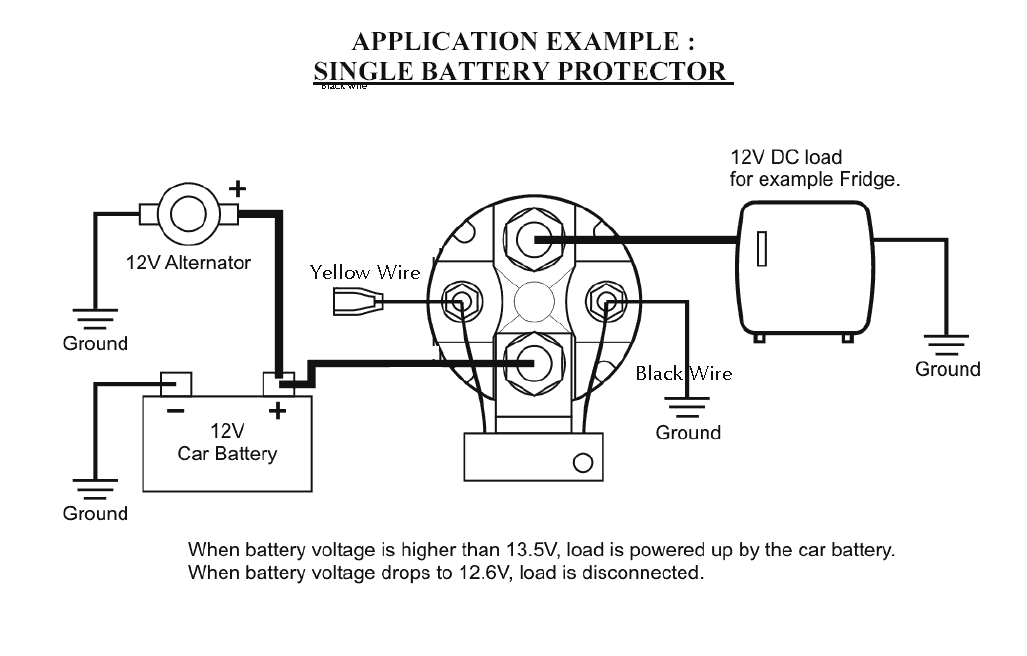

- #Should i wire amp to battery ground isolator how to
- #Should i wire amp to battery ground isolator install
- #Should i wire amp to battery ground isolator full
I also found that using existing wiring for power was the biggest factor to the interference sound. Disconnected negative battery cable and put my digital volt/ohm meter between the battery and the negative. Obviously only having 200mA of output shows that you can't use one on the amplifier itself, just the sound card. You might have to add a small load resistor if your sound card does not draw enough current. connect both of them to the isolator lug designated for the battery in the rear and connect both of them to the rear battery. You shouldn't need 2 1/0 runs to the rear battery, but it's not a problem to have 2 runs. You just have to remember that they are only good for 200mA, they do not do any voltage regulation, and they do require a minimum current on their output. Get yourself a Stinger SGP35 which is up to 500A current. I've been meaning to get a few of those B0505S-1W DC to DC isolators and give them a try. Introduction This ground loop isolator consists of a pair of transformers that allow the signal to pass while galvanically isolating the signals. (07-29-2020, 05:32 PM)frankpintosr Wrote: (07-06-2020, 03:22 PM)jhornbr225 Wrote: I'll agree that a Ground Loop Isolator is not the best solution, and in some cases do nothing to get rid of the noise, and mostly attenuate the audio signal.
#Should i wire amp to battery ground isolator how to
if someone could tell me whether or not the Pi can accept SWC controls over its 3.5mm jack and how to decode them, that would be fantastic as the SWC module I have has a 3.5mm output. If a 4 gauge ground wire isn't adequate, like in big SPL systems, then an additional ground wire attached at your ground near the amps and run to the battery ground up front will. The best ground needs is done with a nut and a bolt, with a new hole drilled, and the paint scraped off. The wire to the primary battery, 1, goes into the stock wiring harness that has 2 wimpy 10AWG or so wires in it that go to the battery. Then there are 4AWG wires from the 1 and 2 posts to the batteries. Is there something I'm missing? I don't understand where there could be a ground potential difference and as to why the Pi isn't fully cooperating. This is an adequate ground connection for most installations. Currently with Dearborn's kit there is a 4AWG wire from the alternator to the A pole on the isolator. If you find yourself in need of a battery isolator wiring, here are a few tools and materials needed, as well as steps that can help to guide you. I did notice however that when using the GIPO ground pin in the number 9 slot, it reduced the whine a tad when grounded. 25-50 What You'll Need Whether it is a fuel line replacement or wiring a battery isolator, you can accomplish many seemingly tough jobs on your own. Is your battery going flat or you need to store your car without draining the battery In this super simple DIY video you'll learn how to fix the problem wit. I've tried wiring it to the 12v cigarette adapter with no luck, I've tried grounding both the amp and the Pi in the same spot on a chassis grounding bolt with no luck. With the raspberry pi disconnected from the amp and the 3.5mm connected to my phone, the ground loop whine is gone, but when it is, I notice the classic signs, alternator whine, and changing with engine RPM's.

My amp that I have is wired directly to the wring harness that leads to 12v battery ground. It works great and I don't have to remember to turn a switch and it doesn't allow my alternator to be over worked.Hello All, I have a Raspberry Pi 4 B wired into a 12v to 5v 3A DC to DC connector, this connector is wired directly into the same wiring harness that the amp is. It is very small unit and marine approved so it can handle moisture and vibration. When I shut outboard off as soon as the voltage drops to 12.8 volts the isolator disconnects the two batteries.
#Should i wire amp to battery ground isolator full
When I start my outboard the isolator allows starter battery to reach full charge 13.3 volts before it connect second battery for charging. Also connected the isolator and both batteries to a common ground and it was finished. Simply mounted in next to my starter battery ran a cable from the start battery positive terminal to the isolator terminal "A" then another cable from isolator terminal "B" to the second battery. The nice thing is that I didn't have to connect it to the alternator or the ignition. It is completely automatic and isolates the battery when a charging source isn't available. They were a little higher priced so I shopped around and found it on craigslist.
#Should i wire amp to battery ground isolator install
Simplest install available and I bought it online just google it or you can find it on the DIY website. Very simple solution that I used is an AOPEC Smart Battery Isolator. I could do it that way, howevr the amp has a remote turn on wire from the stereo, so its only on when the stereo is on, so really don't need to worry about that, but, it would be nice to have the option to run the stereo without the amp draining the starting battery, so, utilizing an acr, with the amp wire moved to the aux batt.


 0 kommentar(er)
0 kommentar(er)
